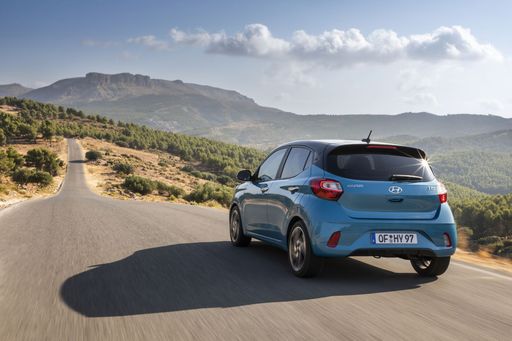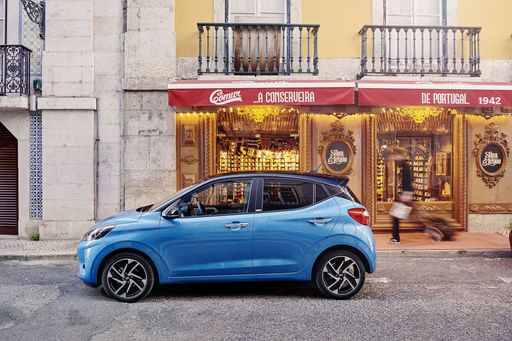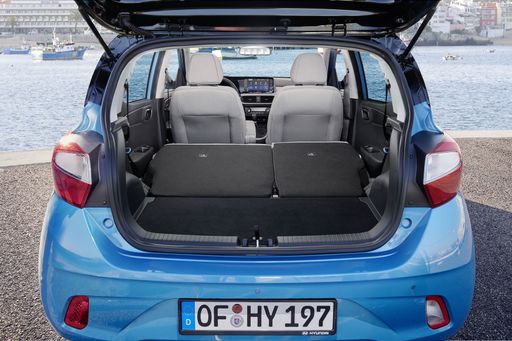Hyundai i10 vs Fiat Pandina – Differences & prices compared
Two cars, one duel: Hyundai i10 meets Fiat Pandina.
Which one wins in performance, efficiency and value for money? Find out now!
Costs and Efficiency:
When it comes to price and running costs, the biggest differences usually appear. This is often where you see which car fits your budget better in the long run.
Fiat Pandina has a slight advantage in terms of price – it starts at 14100 £, while the Hyundai i10 costs 14600 £. That’s a price difference of around 428 £.
Fuel consumption also shows a difference: Hyundai i10 manages with 4.90 L and is therefore barely noticeable more efficient than the Fiat Pandina with 5 L. The difference is about 0.10 L per 100 km.
Engine and Performance:
Under the bonnet, it becomes clear which model is tuned for sportiness and which one takes the lead when you hit the accelerator.
When it comes to engine power, the Hyundai i10 has a distinct edge – offering 90 HP compared to 70 HP. That’s roughly 20 HP more horsepower.
In acceleration from 0 to 100 km/h, the Hyundai i10 is noticeable quicker – completing the sprint in 11.40 s, while the Fiat Pandina takes 13.90 s. That’s about 2.50 s faster.
In terms of top speed, the Hyundai i10 performs barely noticeable better – reaching 175 km/h, while the Fiat Pandina tops out at 164 km/h. The difference is around 11 km/h.
There’s also a difference in torque: Hyundai i10 pulls convincingly stronger with 172 Nm compared to 92 Nm. That’s about 80 Nm difference.
Space and Everyday Use:
Beyond pure performance, interior space and usability matter most in daily life. This is where you see which car is more practical and versatile.
Both vehicles offer seating for 5 people.
In curb weight, Hyundai i10 is minimal lighter – 996 kg compared to 1055 kg. The difference is around 59 kg.
In terms of boot space, the Hyundai i10 offers slightly more room – 252 L compared to 225 L. That’s a difference of about 27 L.
In maximum load capacity, the Hyundai i10 performs slightly better – up to 1050 L, which is about 180 L more than the Fiat Pandina.
When it comes to payload, Hyundai i10 slight takes the win – 423 kg compared to 385 kg. That’s a difference of about 38 kg.
Who comes out on top?
Overall, the Hyundai i10 shows itself to be dominates this comparison and secures the title of DriveDuel Champion.
It convinces with the more balanced overall package and proves to be the more versatile choice for everyday use.

Hyundai i10
Hyundai i10
The Hyundai i10 impresses with its compact design, making it an ideal choice for navigating through busy urban environments. Its interior is surprisingly spacious, offering drivers and passengers comfort beyond what one might expect from a city car. The model combines efficiency and practicality, making it an attractive option for those seeking both economy and functionality in their daily commute.
details @ hyundai.news
@ hyundai.news
 @ hyundai.news
@ hyundai.news
 @ hyundai.news
@ hyundai.news
 @ hyundai.news
@ hyundai.news
 @ hyundai.news
@ hyundai.news
Fiat Pandina
The Fiat Pandina, commonly referred to as a spirited urban companion, boasts a charm that's both nostalgic and contemporary. Its compact design embraces city streets with an agile grace, making it an excellent choice for bustling environments. With a reputation for reliability and an economical approach, the Pandina continues to win hearts as a beloved everyday vehicle.
details

|
|
|
|
|
Costs and Consumption |
|
|---|---|
|
Price
14600 - 19000 £
|
Price
14100 - 18000 £
|
|
Consumption L/100km
4.9 - 5.5 L
|
Consumption L/100km
5 - 5.1 L
|
|
Consumption kWh/100km
-
|
Consumption kWh/100km
-
|
|
Electric Range
-
|
Electric Range
-
|
|
Battery Capacity
-
|
Battery Capacity
-
|
|
co2
110 - 124 g/km
|
co2
113 - 116 g/km
|
|
Fuel tank capacity
36 L
|
Fuel tank capacity
38 L
|
Dimensions and Body |
|
|---|---|
|
Body Type
Hatchback
|
Body Type
Hatchback
|
|
Seats
4 - 5
|
Seats
4 - 5
|
|
Doors
5
|
Doors
5
|
|
Curb weight
996 - 1099 kg
|
Curb weight
1055 kg
|
|
Trunk capacity
252 L
|
Trunk capacity
225 L
|
|
Length
3670 - 3675 mm
|
Length
3635 - 3705 mm
|
|
Width
1680 mm
|
Width
1643 - 1662 mm
|
|
Height
1480 - 1483 mm
|
Height
1551 - 1657 mm
|
|
Max trunk capacity
1050 L
|
Max trunk capacity
870 L
|
|
Payload
344 - 423 kg
|
Payload
365 - 385 kg
|
Engine and Performance |
|
|---|---|
|
Engine Type
Petrol
|
Engine Type
Petrol MHEV
|
|
Transmission
Manuel, Automatic
|
Transmission
Manuel
|
|
Transmission Detail
Manual Gearbox, Automated Manual
|
Transmission Detail
Manual Gearbox
|
|
Drive Type
Front-Wheel Drive
|
Drive Type
Front-Wheel Drive
|
|
Power HP
63 - 90 HP
|
Power HP
70 HP
|
|
Acceleration 0-100km/h
11.4 - 18.4 s
|
Acceleration 0-100km/h
13.9 - 14.7 s
|
|
Max Speed
143 - 175 km/h
|
Max Speed
155 - 164 km/h
|
|
Torque
93 - 172 Nm
|
Torque
92 Nm
|
|
Number of Cylinders
3 - 4
|
Number of Cylinders
3
|
|
Power kW
46 - 66 kW
|
Power kW
51 kW
|
|
Engine capacity
998 - 1197 cm3
|
Engine capacity
999 cm3
|
General |
|
|---|---|
|
Model Year
2024
|
Model Year
2024 - 2025
|
|
CO2 Efficiency Class
C, D
|
CO2 Efficiency Class
D, C
|
|
Brand
Hyundai
|
Brand
Fiat
|
Is the Hyundai i10 offered with different drivetrains?
The Hyundai i10 is offered with Front-Wheel Drive.
The prices and data displayed are estimates based on German list prices and may vary by country. This information is not legally binding.
